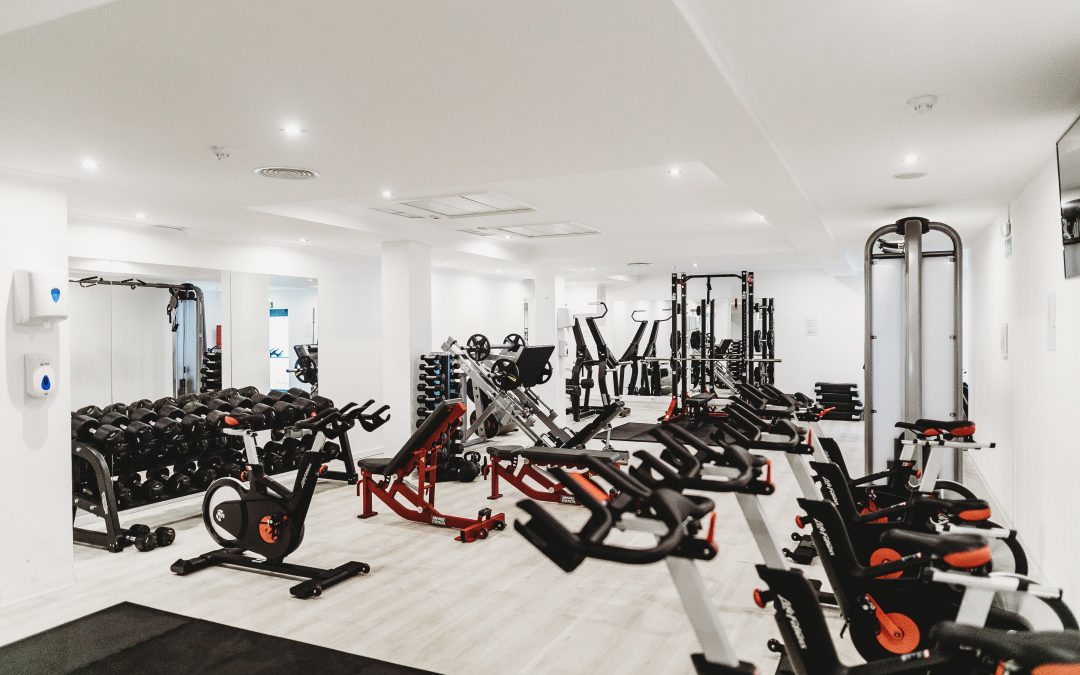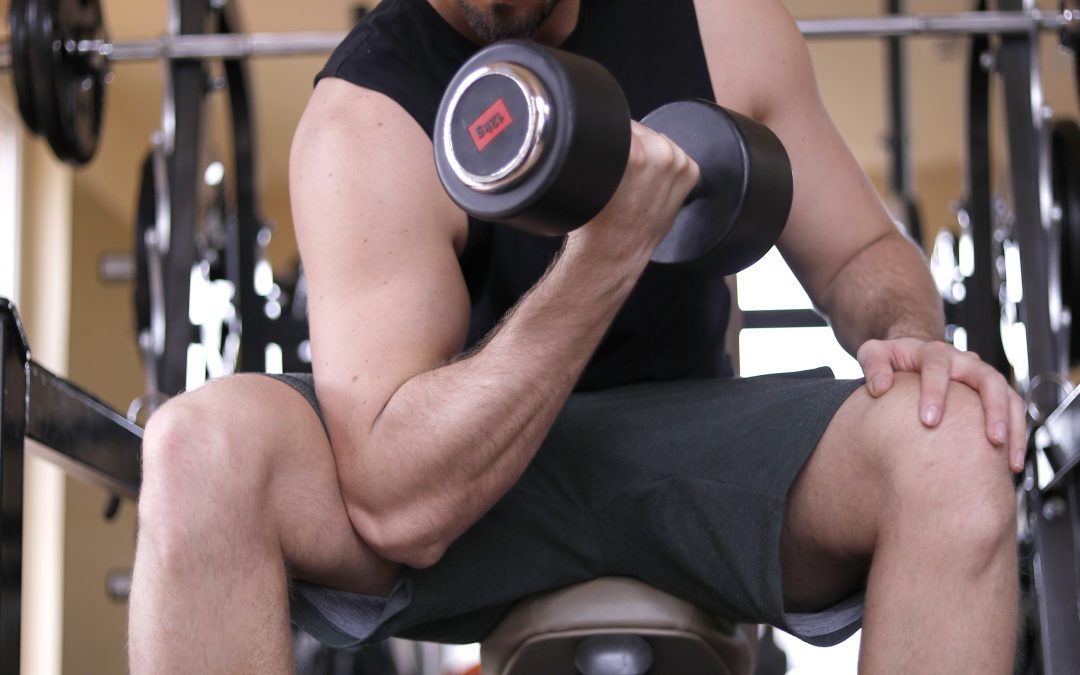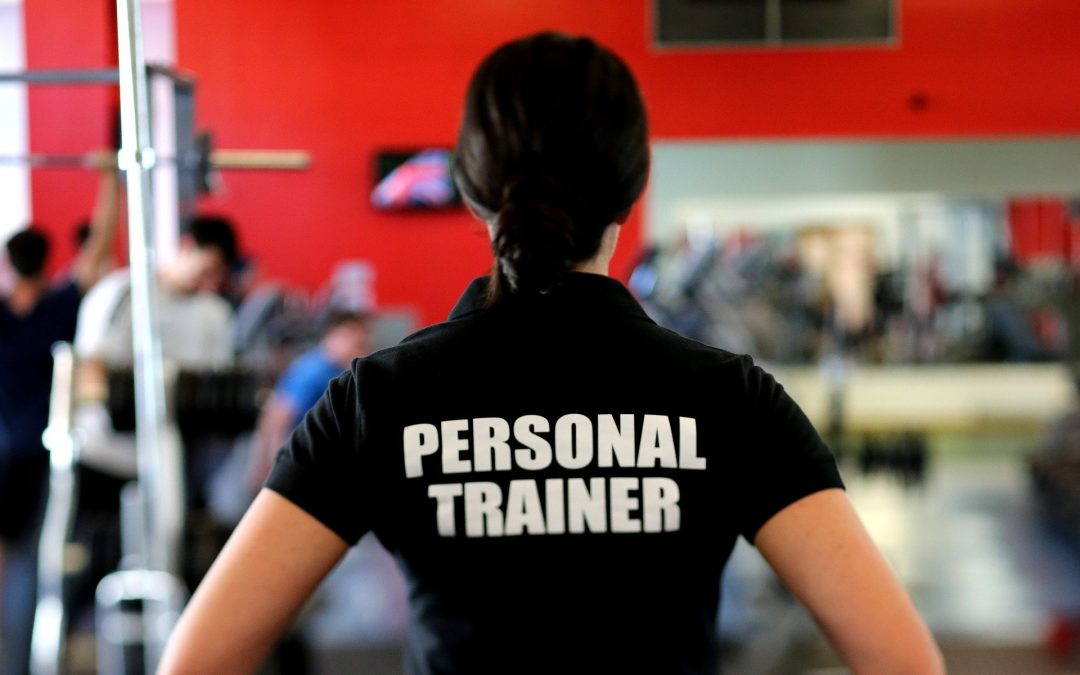
How many steps should you take daily?
With the convenience of fitness trackers and mobile health apps, tracking your daily fitness has never been easier. The average total steps everyone is advised to do per day is 10,000 steps, which is equivalent to 5 miles. The Centers for Disease Control and Prevention (CDC) recommends at least 30 minutes of exercise per day, or 150 total per week. Before the time of Fitbits and other health trackers, however, the 10,000 number was first used in Japan during the mid-60s in a campaign to promote a pedometer. Studies by Bio Med Central (BMC) show that the average human can walk from 4,000 to 18,000 steps per day, depending on stride and lifestyle. 10,000, being somewhere in the middle, is said to be the reasonable amount of steps for a healthy person.
Walking 5 miles per day meets that recommendation, however, different health conditions and goals may differ. It’s great to know how much per day is a healthy amount of steps, but you should also consider if you have any underlying health issues and what kind of goals you want to meet. You may be able to do more if you’re able to, or if you would like to lose weight. You can also do less if you may be recovering from an injury, or just starting out a new fitness routine. Over time, your endurance builds up anyway. The more used to walking you are, the easier it gets for you to walk more. It’s also easy for us to get caught up in tracking the numbers, but at the start you may just want to do more than your usual routine, without looking at the numbers.
According to leading fitness tracker company Fitbit, here are some common goals you may want to achieve:
General Exercise and Gains
The Mayo Clinic advises those who are newer to exercising or recovering from injuries to be able to do at least 1000 steps per day, or 5000 per week. This can be made easier by exerting in more effort, like choosing to walk to nearby places you would normally go to with a car, or parking further than your usual parking spot, depending on how fast you can walk. To be able to start, see how much you do per day and then gradually try and do more than what you do regularly. Work at a comfortable pace and try to maintain the same amount for a week or two, until you’re ready to do more. Repeat this until you’ve reached the average 10,000, you’ll be doing more in no time.
Improvement and maintenance
Maintaining your newfound fitness level can be done by keeping at the 10,000 mark. Being able to do this many steps can help reduce the risks of high blood pressure and other heart-related conditions like strokes.
Weight Loss
The numbers really depend on a couple of factors: age, gender, diet, and even lifestyle. However, if your goal is to lose weight, it is fair to say that 10,000 and above is the number of steps to aim for. If you’re already doing 10,000, you can start by gradually going up a couple of steps.
A study by the Academy of Nutrition and Dietetics recommends a slower pace at losing weight, typically ½ pound or 1 pound per week, and completing 10,000 steps per day is equivalent to 2000 to 3500 calories per week! A pound of fat is more or less equal to 3500 calories. Depending on your lifestyle, you could be losing this much just by doing some walking, which is often underestimated as a workout.
Walking is also a very easy thing as it is already incorporated into our usual lifestyles, no matter how much they differ. Many people from different age groups are able to do walking, and the difference lies in the stride and distance. Some useful tips for incorporating more time to walk into your daily routine may include:
- Don’t try and do 10,000 steps all at once, remember it is equivalent to approximately 30 minutes of exercise. Try to break it up into certain times during the day.
- Take the stairs! I know it’s so much more convenient taking the elevator, but you’ll be able to reach your goal faster when you climb those stairs, get your heart going, too.
- Walk to where you would usually take the car to. If the distance is fairly near, and the weather is nice, opt for a walk. Get that much needed vitamin E while you’re at it.
- Pace while you talk to someone or are doing something on your phone, anything you usually do in place or sitting down can be done standing up or walking!
Don’t feel pressured not being able to complete your goals at first. There are many factors that go into our day, if you don’t have the time to walk, there’s always tomorrow. What’s important is that you exert an effort to go the extra mile for yourself.

Main Types of Exercise Equipment
Developing an effective fitness routine starts with first knowing your body’s limits and identifying which works best for you. Do you enjoy high-intensity workouts that get your heart rate up and pumping? Do you want to build or tone muscle in certain areas? By recognizing which certain area you’re in the gym for, this makes it easier to pinpoint which pieces of equipment you’ll be frequenting. Although both types of exercise work hand-in-hand to prove the best results, it will be easier knowing which machine is which. We break this down into two categories: cardio equipment and strength training equipment.
CARDIO EQUIPMENT
Cardio is a form of exercise to get your heart rate up. This is to ensure that your heart is able to endure more forms of movement with half the effort, meaning you don’t tire easily. This, in turn, can also lower your risk for cardiovascular related problems such as heart attacks, high-cholesterol, high blood pressure, and even diabetes. As an exercise, it is meant to help burn fats and calories and help you stay lean.
TREADMILL
A treadmill is a machine that is generally flat or sometimes inclined, almost like a ramp. It helps with walking, jogging or running at various speeds, inclines and intervals. Most treadmills are also able to keep track of how many miles you’ve ran, how many calories you’re burning per minute and can also monitor your heart rate which is essential to your training. You don’t want to push yourself too much when training for the first time. Running on these machines can also increase your endurance, making you run more miles at a faster speed. This is a great machine to shred some pounds.
ELLIPTICAL TRAINERS
Elliptical trainers work in a somewhat similar manner to a treadmill. Such machines can have you stair climb, cycle, walk, or run. You can also change its speed, intensity and resistance. These were designed to cause less injury or stress to your joints: mainly the hips and knees and work great for the upper body as well. These make for a good workout but burn less calories because of the lower impact at 500-600 calories per hour at a speed that is above average.
STATIONARY BICYCLES
Stationary bicycles look exactly how they sound: like a real bicycle without the wheels. They target the heart while building up the leg muscles. These are also effective machines to get in a good cardio workout, but they can be uncomfortable for long periods of working out. The average man may burn around 675 calories per hour on a moderate speed, and up to 1150 on a vigorous cycle such as spin classes.
STAIR STEPPERS/CLIMBERS
These machines mimic the appearance of actual stairs and help monitor how many flights of stairs you have climbed. It is a great device to get in that cardio while working your major lower body muscles because your glutes, hamstrings, quads and calves are all working. However, those with weaker knees must take caution in using such machines, or may have to stay away from it altogether as this can strain the joints even more. On average, 500-600 calories per hour are burned.
ROWING MACHINE
A rowing machine essentially gives you the work and feel of how it feels like to row a boat in the water. This simultaneously works the arms, legs and back, which makes for total body conditioning. It’s also a great way to condition the posterior chain. This machine and range of motions can help burn 800 calories up to 1000 calories, depending on how high of intensity one is going.
STRENGTH TRAINING EQUIPMENT
Strength training helps to develop and tone different muscle groups, be it by using one’s own body weight, external weight or even gravity and building strength through these. This part of the gym is where you will find different kinds of weights and resistance equipment.
DUMBBELL RACK
Gyms have a variety of dumbbells available, the lightest being 2 pounds to 200 pounds. They come in a variety of sizes, shapes, and materials. Some gyms have plastic-coated colorful dumbbells with certain colors corresponding to their weight, while others may have straight metal ones. These can be used in many different kinds of arm workouts. Beginners should start with lighter weights and work their way up to heavier weighted dumbbells.
BARBELL RACK
Barbells are exercise equipment used for weight training and weight lifting. Comprising of a barbell standard of 5 to 6 feet long and weigh between 15 to 20 pounds and weight plates that vary in weight. Different types of barbells are used in various settings, some common ones are the Olympic barbell, which is more commonly used for increased strength while squatting, deadlifting and bench pressing using both arms. Another common one is the EZ Curl Bar, which already comes with fixed weights and are significantly shorter than Olympic bars. These are meant for use with one arm at a time, doing exercises geared towards the biceps and triceps like bicep curls and triceps extensions.
MEDICINE BALLS
These are weighted balls that come in different weights. While these balls were originally used for rehabilitation of injuries, they have found their way to the gym. They are used for a variety of different exercises, the most common being wall slams by throwing it. You can also catch them, lift them or use them for balance. They can help strengthen lower-body muscles like hamstrings and glutes. You can use these doing lunges with chest twists to add to the challenge, or you can also use them for core work to build the abs.
RESISTANCE BANDS/TUBES
Resistance bands and tubes basically look like oversized rubber bands and are used for a multitude of exercises similar to weight training. They can be used wrapped around above the ankles or around the thighs while doing exercises such as squats or donkey kicks to build up muscles in the glutes. Although they prove effective for lower-body workouts, they can also help in toning the arms and work somewhat similarly to lifting weights.
TRAINING BENCH
Training benches are not only used for resting, in fact they can be used in many different exercises. They are used for the likes of weightlifting and even body weight exercises such as triceps dips.
Gym equipment can be overwhelming for a first timer but over time you will learn to familiarize yourself with them, and there will always be someone around to help.

Using Exercise to Reduce Stress
With work piling up, chores to finish at home, and hardly any time for leisure, stress can often feel inescapable. Having time to oneself in front of the TV can feel like the best solution, with the bed being one’s only refuge. However, there is one all-natural way to feel better, but not everyone likes to hear it: try getting some exercise.
Stress is a universal problem. The Anxiety and Depression Association of America says that seven out of ten US adults experience stress or anxiety daily, often interfering with their lives. According to the Mental Health Foundation’s 2018 study, 74% of respondents in the UK had felt so stressed in the past year, they had been overwhelmed or unable to cope. One affordable and accessible solution to stress is physical activity. Here’s exactly how it helps.
Endorphins and endocannabinoids from physical stress
It’s hard to believe that a form of physical stress can lead to a relief of mental stress, but that’s exactly what happens when you exercise. The main mental benefit that exercise offers is the release of endorphins. Endorphins, also known as the brain’s feel-good neurotransmitters, are credited with causing the feelings associated with “runner’s high,” making those who experience it crave it again and again.
A 2015 study in the Proceedings of the National Academy of Sciences of the United States of America also found that endocannabinoids, a natural version of the THC or tetrahydrocannabinol identified in cannabis, may play a role just as important as endorphins in the experience of runner’s high. According to the researchers, endocannabinoids may have helped ancestors stay focused and alert while hunting for food. It is these brain chemicals that remain active today as we exercise.
Prolonged exercise is to thank for the release of endorphins and endocannabinoids. The constant physical stress put on the body triggers the spread of these brain chemicals, allowing for feelings of happiness, gratitude, and motivation.
Repetitive motions
Stress has a tendency to grow until it becomes overwhelming. The repetitive motions that you make when you exercise can call your attention to your own body. Exercise requires you to be fully present and focused on what is happening in the now, with the weights you’re carrying or the treadmill you’re running on. This need to concentrate on your body and every movement you make takes pressure away from your mind, giving you a sense of calm. Many refer to this experience as meditation in movement.
According to Harvard Health Publishing of Harvard Medical School, the meditative movement itself is often prescribed for the alleviation of depressive symptoms. Meditative movement occurs when you focus on the sensations your body is feeling, from your breaths to your heartbeat. This would also allow you to re-evaluate your position amid your environment and surroundings. Meditative movement is most present in practices such as yoga and tai chi.
Other health benefits
While stress is rooted in emotion, it often translates to physical symptoms. If contained to the mind, stress can cause irritability, worry, insomnia, anger, hostility, restlessness, and feelings of dread. Physical symptoms of stress, on the other hand, include headaches, neck pain, back pain, tense muscles, a dry mouth, and thirst. One’s skin could become pale, throat could feel blocked, or stomach could act up in a way that either feels like butterflies or diarrhea. The worst symptoms include chest tightness, problems breathing, excessive coughing, hyperventilation, and fainting. The point is that stress is a real thing, and is by no means a figment of the imagination. The physical symptoms could become so hard to manage, they only worsen the mental symptoms one feels.
It makes sense then to physically exercise in order to hopefully affect the mind, breaking the cycle of stress adding to the stress. Exercise strengthens the body’s immunity, lowers blood pressure, strengthens bones and muscles, improves blood circulation, and boosts levels of good cholesterol in the blood. It also contributes to weight loss, improves self-image, helps with sleep problems, and boosts energy. Many have said that regularly exercising improved their mood, gradually making them feel better over time.
Exercising to get rid of stress
Generally, people are advised to get at least 150 minutes of moderate aerobic activity each week. The American Heart Association suggests doing this by holding five 30-minute workout sessions throughout the week. According to the health guidance website Healthline, any type of exercise would help with stress.
Any moderate aerobic exercise like walking, jogging, biking, dancing, or swimming would work. High-energy activities like aerobic exercises cause your heart rate to rise, releasing the endorphins your mind needs. Before doing these exercises, be sure to consult your doctor for their go-ahead.
If you can’t do moderate or high-intensity exercises, go for practices like yoga, a mind-body exercise that’ll have you combine movements and poses with deep breathing. The mind and body are more connected than one might think. Yoga, tai chi, and pilates are great self-paced exercises that focus on balance, strength, and calming the mind. All three have been credited with stress relief.
Play a game of tennis if you’d rather do something fun with friends. If you absolutely don’t have the time to exercise, make the right choices in your daily life to contribute to your physical activity. For instance, if you’re faced with the choice of taking the elevator or the stairs, remember that even a little bit of constant physical activity could give you the emotional high you need.
Always settle on an exercise or activity that you actually like doing. Having to accomplish an exercise that you hate every morning would only add to the stress that you already feel. Remember that exercising is supposed to make you feel good. If none of the previously mentioned exercises appeal to you, find one that you’ll enjoy.
Of course, you don’t have to exercise alone if you don’t want to. Ask a friend or family member to join you; their presence would not only make your workouts more fun but provide you with the support you need to keep going.

Using Kinesio Tape During Workouts
Kinesio Tape or Kinesio Tex Tape is a modality that has been around for quite some time. It was developed in Japan by Dr. Kenzo Kase, a chiropractor, in 1973 after his trials and errors using other adhesive tapes that were commercially available at the time. This tape is made from a blend of polymer elastic strands or nylon, and cotton, water-resistant very flexible material that mimics the elasticity of skin so wearing this will not restrict movements and ranges of motion, which makes it different to the traditional athletic strapping techniques, as these are more restrictive and are usually taken out after their intended use, like the end of an athletic event.
This method of taping is a rehabilitative taping technique that can help speed up the body’s natural healing process for a couple of different systems. These are worn around the joints, more commonly the knees, to provide added support. Other systems include: the circulatory system, the neural system, the muscular system, and orthopedic systems.
Therapists are using this tape for altering the tones of muscle, shifting or draining the lymphatic fluids, and even improving posture. This is done by wrapping said tape around these systems that need the most help. Some conveniences of this tape include the very low price range than other quantities of tape and garments that are said to do the same thing. They are also easy to wear and can be worn over longer periods of time, usually over a period of days.
Kinesio Tape, despite its flexibility, is also able to stabilize the muscles and aid in proprioception. This is the awareness of muscle engagement. Because of this, Kinesio Tape is used by physiotherapists, occupational therapists, manual therapists, nurses, physicians trainers, athletes, and chiropractors like Dr. Kase himself – although a majority of non-athletes have also adapted to using these tapes.
Common uses for Kinesio Tape are:
- Treating Injuries – Kinesiology can help with alleviating pain and minimize swelling, but only as an addition and not the main treatment.
- Supporting Weaker Areas – Kinesio Tape can be wrapped around muscles or joints that may need rehabilitation including:
- IT band injuries (iliotibial band syndrome) which involve knee pain
- Hamstring injuries
- Achilles tendonitis (pain at the back of the ankle or lower calf)
- Shin splints (medial tibial stress syndrome) which involves inflammation around the tibia Rotator cuff injuries (scapula to humerus area)
- Tennis elbow (lateral epicondylitis) affecting tendons in the wrist and fingers, down to the epicondyle
- Plantar fasciitis or heel pain
- Training/Altering Muscles – The tape can help muscles that have taken on a more unhealthy way of working. This can also help improve posture and position, like in the head and neck.
- Improved Performance – Athletes wear these to help achieve maximum performance levels, these are commonly seen being worn by volleyball players, as well as runners. It is worn to help prevent injuries while training and competing, as well as to wake up certain muscles to work them.
- Scar Appearance – Some studies suggest that wearing Kinesio Tape, while not advised to be worn on open wounds, they can eventually improve the appearance of scars over time.
Evaluation of one’s present medical conditions and needs will help you understand which areas to treat and if you can even use Kinesio Tape at all. A full assessment by a medical professional would be needed before use because Kinesio Tape can also be harmful to the following:
- Deep Vein Thrombosis (DVT) – Kinesio Tape increases mobility and blood/fluid flow could possibly cause blood clots to dislodge and can even be fatal if this leads to a pulmonary embolism which is a blockage of arteries in the lungs.
- Lymph Node removal – Increased blood/fluid flow can when a node has been removed can potentially cause swelling.
- Diabetes – Persons suffering from diabetic conditions can also experience peripheral neuropathy which is a condition where there is altered sensation in the legs or arms, which can also cause numbness to the effect the tape has on the body.
- Open wounds – Tape can potentially cause the growth of bacteria to enter the wound causing an infection.
- Active cancer – An increase in blow flow can be hazardous to those undergoing cancer treatments.
- Allergic reactions – Those that are allergic to adhesive will experience discomfort as Kinesio Tape is worn sometimes for days at a time which can cause the skin to react and an allergy to develop.
Kinesio tapes are applied in X, Y, I, and cross patterns depending on your need and goal. While Kinesio Tape claims to have a lengthy list of benefits, always keep in mind that it is best to get to the root of your pain or discomfort, if experiencing any. Kinesio Tape is used to aid and assist but not solve the entire problem.
Image “Kinesio Tapes” by MipMed is licensed under CC BY 2.0

Best Time of Day to Workout
There are early birds and there are night owls. In the context of the gym, does the time one chooses to be active really matter?
Some people flock to the weights before the sun even rises to start their day on a productive note, while others prefer to work out by themselves once the rest of the world has gone to sleep. Most people, on the other hand, have no choice but to squeeze in exercise whenever they’re able, whether that’s before or after work.
It’s important to consider how exercising at different times of the day can affect not only your health, but your mood.
Morning exercise
You’ll have more control of your time. Morning exercise offers a number of benefits, most of which have to do with time. Working out in the morning is the best option for people who have difficulty maintaining the habit of exercise. Scheduling exercise for first thing in the morning not only ensures that it’ll be at the top of your to-do list for the day but keeps you more focused on other tasks. In an interview with TIME, Cedric Bryant, PhD, a chief science officer with the American Council on Exercise in San Diego, said, “Research suggests in terms of performing a consistent exercise habit, individuals who exercise in the morning tend to do better.”
You’ll have better weight loss success. Exercising in the morning is also the best for weight loss, considering that the workouts would be done on an empty stomach. In the morning, the body has higher levels of growth hormone and cortisol, which play a role in metabolism. This forces the body to seek energy from body fat. A study by Brigham Young University published in the Medicine & Science in Sports & Exercise journal also found that people who exercise in the morning have less of an appetite the rest of the day, adding more reason to exercise early in the day if one wishes to lose weight.
Your body clock changes. Because your body would get used to waking up early to exercise, it can also make you feel more alert as your body clock shifts earlier. According to a study published in the February 2019 issue of the Journal of Physiology, it’s possible that exercising at 7 a.m. can affect your body clock so that your body expects you to wake up earlier and sleep earlier every day.
You’ll feel better. Exercise also triggers the release of endorphins, which means that exercising in the morning will only put you in a better mood than when you woke up. Exercise also allows for complete focus on the body’s movements, which is why it’s often regarded as a type of meditation. Equipped with feel-good hormones and reduced stress, you’ll feel more in control every morning that you choose to exercise.
With all of these advantages to working out in the morning, you might feel tempted to force yourself to get yourself to the gym even if your body protests. Don’t do this. Exercising at an extremely low intensity level isn’t worth the energy, so save your workouts for when you’re feeling up for it. Body temperature is also often lower early in the morning, which means that you’ll have to allot more time to warming up than you usually would.
Afternoon exercise
It’s great for high-intensity workouts. Working out in the afternoon probably means that you’ve already had something to eat. While morning workouts on an empty stomach are great for weight loss, eating adds to the glucose your muscles can use while exercising. Body temperature is also highest in the late afternoon, further improving performance.
It can wake you up. It’s tempting to take a nap in the afternoon or come home early to retire before the sun even sets. Just as exercising in the morning can reset your body clock, exercising in the afternoon can help you keep awake and focused until it’s actually time to sleep.
Your body burns more calories in the afternoon. A 2018 study published in the Current Biology journal found that humans naturally burn around 10% more calories, amounting to 130 calories, in the late afternoon. They credited this to the body’s internal clock. However, the calorie burn recorded in the study occurred during natural bodily functions and not exercise.
The biggest problem with working out in the afternoon is time. You’re more likely to encounter distractions throughout the day or have errands that need to be done, which makes squeezing in a workout harder to do.
Evening exercise
It can help you sleep. Contrary to popular belief, there’s evidence to suggest that evening workouts do not interfere with one’s sleep. Researchers’ assessments of the 2013 National Sleep Foundation Sleep in America Poll found that although “morning vigorous exercisers had the most favorable sleep outcomes,” people who exercised in the evening had equal or better quality sleep.
It’ll contribute to your weight loss. A 2019 study published in the Experimental Physiology journal found that evening exercises can reduce levels of ghrelin, a hormone known to stimulate feelings of hunger. This suggests that exercising at night could aid in weight management or weight loss.
You’ll have better mornings. Without the pressure of having to wake up early, you can sleep in and not have to sacrifice precious shuteye. Just preparing one’s clothes, bags, and toiletries to head to the gym in the morning can often be quite stressful, so leaving exercise for the evening would make mornings more bearable.
The worst part about exercising at the end of the day is that other people usually have the same idea. The gym can get too crowded for a decent workout, while the streets can get too busy for a peaceful run. At the same time, distractions at work and at home are all too welcome.
The point
There are pros and cons to working out at any time of the day. What’s important is that you make the time to get those active hours in and to do it consistently. Look at your schedule and your lifestyle, then decide what time of the day works best for you. Only you can say if it’s working.

The Body’s Essential Vitamins
Vitamins are organic compounds that the body needs to perform many necessary functions, but cannot make in sufficient quantities. They need the boost from either taking in food that is rich in these compounds or by taking oral supplements. Eating food directly gives you the whole compound, though, which is important to keep in mind.
Vitamins generally help in many bodily functions, such as boosting the immune system, growing and repairing broken tissues, and even regulating one’s metabolism. Here’s a list of all the vitamins that are essential to one’s body.
- Vitamin A – This fat-soluble vitamin plays a necessary role in the growth and health of teeth, bones, soft tissues, mucous membranes, skin, and cell development. It’s mainly found in carrots and other foods that share the same hue, like sweet potatoes, cantaloupe, and melons. They are also known as carotenoids which aid in improving your vision and help fight off chronic diseases.
- Vitamin B1 (Thiamine/Thiamin) – These vitamins are good for maintaining healthy energy metabolism. This is commonly found in the likes of pork, legumes, fish, nuts, seeds, fortified cereals, grains. People with certain health conditions might require more of this supplement as their conditions make them heavily lack it, like those with HIV and diabetes. Those that drink quite a lot of alcohol may also be lacking. Thiamine deficiency may be found in symptoms like weight loss, memory loss, muscle weakness and even an enlarged heart. Sometimes this can also include mental symptoms.
- Vitamin B2 (Riboflavin) – This is a vitamin that the body needs for optimum energy production, as well as cell growth, adrenal function and development. This can also help with maintaining healthy skin. Commonly found in organ and lean meat, eggs, milk, and vegetables. Some grains may also be fortified with riboflavin. Taking this supplement might make urine appear more yellow than usual.
- Vitamin B3 (Niacin) – This B vitamin is essential for converting food into stored energy. In larger amounts, B3 can also lower cholesterol. It is commonly found in foods like meat, poultry, seafood, milk, eggs, fortified bread, and cereals. Vitamin B3 deficiency is called pellagra, which can also manifest not just physically (dermatitis), internally (digestive problems) but also mentally (dementia). Side effects of this vitamin at some doses can include flushing on the skin.
- Vitamin B6 (Pyridoxine) – An overall essential for good health, Vitamin B6 promotes protein metabolism, metabolism of carbohydrates, and release of energy which in turn helps in proper brain function and regulation of moods because of manufacturing neurotransmitters. These can be found in beef liver, lean meat, legumes, fish, vegetables especially starchy ones like potatoes. Deficiency in this vitamin is linked to irritability, depression, short-term memory loss and the like.
- Vitamin B12 (Cobalamin) – Helps you break down food for energy. The body also finds this useful for forming DNA, RNA, and myelin for nerve fibers. This kind of B vitamin is found in most animal products like dairy. Deficiency in this vitamin may also result in gastrointestinal disorders thus affecting the optimum nutrient absorption.
- Vitamin C (Ascorbic acid) – This vitamin is very well-known for a couple of great reasons. It is a natural antioxidant that can aid in many things like bone health, skin, and muscle healing. It can also help boost the immune system which is why people like to take this is every day. It is found in a plentiful amount of food, including citrus fruits like oranges, lemons as well as papaya, strawberry, kiwi, cantaloupe. Vegetables like broccoli and bell peppers may contain it as well. Safe to say that because of its commonness, humans typically get their daily needed dose of vitamin C. This is also a water-soluble vitamin, which means you will need to take it in regularly to be able to maintain your adequate intake.
- Calcium – This is a mineral that must be taken to improve the quality and strength of the teeth and bones. Good sources of calcium include dairy products like milk, yogurt, and cheese. Vegetables like broccoli and other leafy ones also contain calcium. Sardines, salmon, cereal, and even orange juice are some of the other foods that contain this. Certain groups of people are at a higher risk for calcium deficiency, people that suffer from anorexia, and those that are excessively athletic. Calcium deficiency may manifest in many bone-related diseases and even joint pain.
- Vitamin D – This is a fat-soluble vitamin that the body needs to regulate cell growth and enhance immune functions that can help to combat different kinds of diseases and infections. This vitamin is found in a various selection of foods, but the best way to really manufacture this is by spending time in the sun. There are times of the day when the sun is not as harmful as later that day, like during the early morning until 10 am. Sun exposure for 10-15 minutes is a good amount of time to spend soaking up some rays, but too much at the wrong time may put you at risk for skin cancer so be mindful of this.
- Vitamin E – Another great antioxidant vitamin that combats free radicals. These are produced by things that can break cells down like cigarette smoke and pollution. A multitude of nuts and seeds contain this vitamin including sunflower seeds, almonds, peanuts, and hazelnuts. Those with nut allergies have the alternative to find them in flower oils such as safflower and sunflower oil and a handful of vegetables. However, be cautious about bleeding because vitamin E can increase this.

5 Ways to Increase Protein Intake
Protein holds a variety of different health benefits. It can help you eat less but lose more weight at the same time. This is because protein is known to help keep you feeling full for a longer amount of time. A high protein intake also increases muscle mass so this can really aid in effective weight loss. It is also known to speed up your metabolism and even build and repair muscle. Proteins are also essential to other productions of hormones, enzymes, and red blood cells.
The recommended amount for daily protein intake is around 46-56 grams, which is a fair amount, although eating more than this likely wouldn’t hurt. An egg is equivalent to 13 grams of protein, but there are tons more of things you can do to increase your daily intake. It is also important to note that there are certain times when protein can be more effective than others.
1. Eat your protein first.
Protein is proven to keep you feeling full for a longer amount of time, make sure you eat it before anything else. This is because protein increases the production of Peptide YY (PYY), a hormone that makes you feel full. Protein also decreases levels of the Ghrelin, more commonly known as the “hunger hormone”. High-protein intake will overall improve your metabolic rate.
To do this, you can choose to have a protein-rich breakfast. Cereal can contain protein, but it does not really keep you feeling full for long, and can result in overeating. Choose eggs over cereal as this contains more protein, and it will give you the energy you need for the morning. Consume protein and vegetables before all high-carb foods. Eating protein at this certain point in your day can also prevent blood sugar and insulin from shooting up too high.
2. Swap it out.
Some food you believe to be high in protein actually have alternatives that contain even more protein than their common counterparts.
Examples of this may be:
- Swapping out your regular yogurt for Greek yogurt. Regular yogurt may be packed with other additives and excess sugar. Greek yogurt, on the other hand, especially the unflavored variant may contain up to 20 grams of protein per serving.
- Snacking on cheese instead of junk food! It feels indulgent and some even contain the same amount of protein as drinking a glass of milk!
- Go for leaner meat than fatty ones. Meats like ham or roast beef contain too much sodium, instead go for turkey or tuna, whichever one will surely give you a protein boost and leave you feeling full for a couple of hours!
- For those who are going vegan, did you know that chia seeds and water can replace eggs in your recipes? They contain about 5 grams of protein per ounce and can even improve the texture in your baked goods.
3. Top your food with almonds.
Almonds contain so many healthy properties like magnesium, fiber and monounsaturated fat. Almonds are said to contain 6 grams of protein in a serving of 1oz. This makes almonds a better source of protein than other nuts. They’re also known to contain a fair amount of good fat, most of which is absorbed by the body anyway. They also add a crunch and salty taste to your food, they can go well over stir-fried veggies and other kinds of salads. Yum!
4. Mr. Beans
Adding beans to anything and everything can make for a great source of protein. They are rich with fiber and contain around 15 grams of protein per cup. You can find these in garbanzo beans (chickpeas), white beans, lentils, kidney beans and also black beans. They can be added to so many foods, and may even be made into burger patties for a plant-based protein alternative.
5. Protein powders and supplements
Powders and supplements have increased in demand as they are an easy alternative. The most important of choosing a powder or supplement is to identify how much biological value (BV) score is in it. This number indicates how the body is effectively able to make use of the protein. Whey is one of the more popular options as it contains a BV score of 104, making it an excellent source of usable protein. Other options include casein and soy. Powders are usually added to smoothies to make protein shakes, something that you can take before or after working out.
Note: Before making any change to your diet, it is recommended to speak with a dietician or other medical professional.

Top 5 Exercises to Get a Six Pack
Abs are one of the most stubborn areas of fat to work on in the body. It requires consistency and determination, an appropriate diet, and just the right mindset and self-control to be able to see any results. In other words–it’s tough work and doesn’t happen overnight. But with a strong core, you’re able to move in other areas much more easily which means that having rock-hard abs isn’t all for show, it can provide you with health benefits as well. Even something as simple as carrying out your groceries without break a sweat can be helped by a strong core.
Of course you don’t get a six-pack overnight, so don’t be discouraged if you don’t see the results right away. The first goal is typically to be able to shred the unnecessary fat by doing cardio, so it will be easier to tone up since we’re working with more muscle and less fat. Then we can move onto these 5 essential exercises for those washboard abs:
1. The good old plank and its variations.
The plank is an exercise that requires absolutely no equipment, which means you can do it anytime and anywhere, no excuses. You can do it at home, while on vacation, staying at a hotel. Literally, anywhere if there is a little space. So, how does this one go again?
You can start by lying face down on the ground, and then raise your legs up. For the upper body, make use of your forearms to balance. You can ball up your fists or you can even clasp your hands together for a better balance. Elbows should be aligned under the shoulders. If this is too easy for you, you can add moves like lifting an arm and leg or even dip your hips from side to side to target the obliques. Other variations include plank jacks or mountain climbers.
This can help with your core stability, and works many muscle groups all in one move. Apart from your core, the plank can also target your glutes, quads and even your back. The variations are endless with this one, just make sure you’re engaging your core muscles and your form is correct to avoid any injuries.
The bird dog.
Start this by being in high-plank or tabletop position. Engage your core and lift up one arm simultaneously with the opposite leg and then bring them back in to do a crunch. This seems fairly easy but it actually works a lot of muscles as well, like the plank. Correct form also plays a role as even just the slightest hyperextension of the arms can lose its effect on the triceps.
Ab wheel rollout
This exercise has earned its title as a classic and rightfully so, however the piece of equipment it requires is not the easiest to get the hang of. The challenge is really being able to execute it properly, your abs don’t do much of the moving but the exercise is really a challenge for your core to keep you from falling onto the floor by helping you keep your spine in a neutral position so as not to collapse. It’s more of an endurance exercise for your abs and will later on leave them burning, and there is no set reps for these as they are meant to be done until you feel like you can’t do them anymore. Hard core. No pun intended.
4. Side-bends with weights
This one gained popularity since the likes of the 90s or 00s. It can seem pretty easy if you execute it incorrectly, make sure also to be mindful of the weight you choose. Reasonable weights will help for optimum results. This is done by standing fully straight up with feet hip-width apart, back straight and balanced. Remember to activate the core muscles. Slowly lean to the side with the dumbbell in your hand as low as you can go and then use your core to lift you back upright. This can also target the waist, making you look trim and fit.
5. Bicycle crunches
This one really makes you feel the burn – and fast. To do this, lay with your back flat on the ground. As with any ab exercises, having your back rest straight will make sure that you don’t injure the lower back and push from there instead of the core. Lift your neck up to lessen the strain, and with your hands behind your head, bring a knee to the chest to meet with the opposite elbow. When one knee comes in, make sure the other is extended. This imitates riding a bicycle, hence the name. This is great for targeting the rectus abdominis and the obliques.
Gone are the days when we would do a ton of crunches just to get those abs. There are more exercises, some more challenging, some a lot more fun.. but nonetheless these exercises will really speed up the process of seeing those abs.

Pros and Cons of Weighted Vests
Looking for a new challenge? Want to push your body to its limit? Weighted vests might just be for you. A weighted vest is used by those who have already been working out for quite some time and are ready for something more challenging and intense. They make easier exercises suddenly vigorous. These vests can yield many benefits for you like muscular and cardiovascular endurance.
The vests contain pockets in the front and back, which can be filled with steel weights or sand. The pockets are specifically measured to fit the weights to prevent the weights from moving around too much. There are a couple of pros and cons to these vests that you might want to weigh before going all in.
PROS
Added Intensity
These vests can specifically be used to help up the intensity of a workout, but even more so for those that depend on body weight exercises. It adds weight on top of your own body weight, which in turn adds more weight to the core which balances out every other part of the body, which allows a more dynamic range of motions that need extra effort to be executed.
Fully Customizable
Weighted vests give you the option of putting in more or taking out the weights that you put in them. This helps you determine what weight works for your routine, and later on the endurance you build can allow you to add even more weight to the vest. This can help with a consistency throughout your routine as you progress. Weights come in various sizes.
Portability
Weighted vests are way easier to bring around with you than actual dumbbells and kettlebells. Because these vests are wearable, you can complete all the workouts you need to do by using only the vest, which means there’s no more carrying around heavy equipment by hand. You can also bring the vest with you in your suitcase when you travel. There’s really no limit to the things you can do with a weighted vest, even just using it when walking, running or cycling suddenly becomes intense.
Use even when injured
This can also be useful when dealing with arm-related injuries that can make using hand-held weights a challenge or not even allowed. Doing certain workouts with your vest can help you even if you’re only recovering from an injury, whether minor or major. This obviously helps when you want to do your daily routine but can’t because of the injuries.
Added cardiovascular benefit
The resistance adds to the cardiovascular’s overdrive, which strengthens the lungs and a VO2 Max, which is the measure of how the body is able to consume oxygen. It also helps with lactate threshold, which is the intensity when lactate begins to accumulate in the blood.
CONS
Worsening Existing Injuries
While these vests do help you still work out while you deal with pre-existing injuries, they can also run the risk of worsening other injuries like core injuries, should injuries or back-related injuries. Consider also lessening the weight your vest contains while doing this, but it is best to consult a medical expert before going through with training.
Manifesting New Injuries
Introducing the weighted vest into your routine might result in new injuries. While the vest is worn on the shoulders, the weight on the core will still be supported by the rest of the muscle groups, the hips, knees and ankles. Improper form and pushing too much when the body is too tired can result in many different injuries. This can manifest in the form of joint injuries and pain.
Poor Fit Leading To Injury
These vests are supposed to fit you almost exactly, because loose-fitting vests with can become dangerous and disrupt the momentum of your workout. Vests should also not be too tight so as not to disrupt your balance as well. All vests come with adjustable straps but make sure that the vest generally fits right.
Weighted vests are actually harder on the heart and entire cardiovascular system which is what makes them effective. Make sure that your body can handle them by speaking to a medical professional first. Once given the go signal, try first by incorporating the vest into an interval training routine. Interval training is made up of shorter movements and then a period of rest. By doing this, you introduce your body to a new type of exercise gradually. Starting fast can increase the risk or injury or make injuries manifest later on in different ways.
Note: always use fitness equipment, including weights, very carefully. Consult with a professional trainer and/or medical professional before beginning use of weighted vests.

What makes a good fitness trainer?
There are tons of fitness trainers in the world. In 2018, there were 69,000 fitness instructors in the United Kingdom alone. With various gyms offering a number of personal trainers to choose from and self-employed fitness instructors available for training whenever you’re free, deciding on the right trainer for you could be quite the dilemma.
Fitness trainers not only need to create fitness plans for their clients and motivate their clients to keep it up. They also need to have the right personality for the job. Choosing the right trainer could spell the difference between success and failure in the gym. Their voice will be the one you hear pushing you to do those last few squats and push-ups, so make sure that voice belongs to someone you respect.
- They have a passion for fitness
Your trainer should be your role model in the gym. While some of the best coaches of sports like basketball or baseball were never players, a fitness coach should be able to show that they walk the talk. They don’t have to have the largest muscles or the smallest waist, unless that’s what you want. They do, however, have to look the part of a trainer who has a passion for being fit and healthy, and is committed to the lifestyle. Choosing a trainer who practices what they preach will determine how you respond to their instructions.
- They care about your goals
When you first talked to them, did they ask you about what you wanted to get out of your workouts? If they did, that’s a good sign. The right fitness trainer won’t project their own gym goals onto you. If your primary goal is to lose weight, the workouts your trainer gives you should reflect that and, after some time, should begin to show in your body’s transformation. However, it would also be the client’s responsibility to choose a trainer who has had experience in that particular field, whether the goal is sports conditioning, flexibility, strength training, or weight loss, among others.
- They’re compassionate
Fitness trainers shouldn’t just feel like a disembodied voice shouting at you through your reps and sets. No matter how fit they may be, they’re human too, which means that they should show you compassion throughout your fitness journey. Though it often helps to have a strict trainer to push you to your limits, that type of training doesn’t work for everyone. If you’ve got a bum knee or just have a hard time keeping up with the program, they should be able to empathize with you and adjust. The gym can be a difficult place to get used to, and if you don’t have a gym buddy to overcome it with, your fitness trainer’s the only person who can get you through it.
- They want to improve your relationship with exercise
Some trainers are so well-versed in the programs they teach, they can go on and on about their importance without asking how you feel about it. The right fitness trainer will resist the urge to lecture you about what you should do and what you’ve been doing wrong. Instead, they will listen to you, teach you how to exercise correctly, and tweak the program to suit your goals and fitness history. A trainer who doesn’t do this might never know, for instance, that you struggle with bending your joints or have trouble controlling your diet. These little facts will help your trainer build the best regimen for you, but they can’t do this if they don’t care to.
- They have a personality that meshes with yours
The best trainer might have the best background in fitness and the most certifications in the gym, but if the two of you can’t get along or the time you spend together feels awkward, they might not be the right trainer for you. Find someone you feel like you could spend an hour at the gym with every day. However, they should also be tough enough to push you to finish the most difficult exercises. Of course, this all depends on what you want in a personal trainer. Decide if you’d rather have a friendly trainer, a ruthless instructor, or both rolled into one.
- They’re certified
The best trainers are those that have acquired certification from accredited groups and associations, or graduated with degrees in fields such as physical fitness. While a trainer might have the most ripped body in the gym, they also need to have the knowledge to back it up. There’s more to training than just telling clients to use a few machines and do a few body weight exercises. A lot goes into the formulation of a training program, and the right trainer knows this.
- They keep positive
Because trainers are human too, they’re going to have bad days. What’s important is that they don’t let these get their clients down. Some clients will choose to work out every Monday, Wednesday, and Friday. Others work out only on weekends, while a few choose to exercise every single day. The likelihood that these clients will be in the best mood every time they see their trainers is very low. This means that it’s up to fitness trainers to keep morale high in the gym, and keep you motivated. They need to have a positive attitude from the outset, so that their positivity can leak into your daily workouts, especially when you’re at your lowest fitness-wise.
- They teach well
Follow what your trainer says, but don’t do it blindly. Allow them to teach you how specific exercises contribute to your reaching your fitness goals. They don’t have to explain the science behind each workout down to the molecular mechanisms, but they should be able to teach you enough that you get a good grasp of their importance in relation to your form and anatomy. A good trainer will keep your workouts understandable, as this is especially crucial when you eventually need to exercise alone.

